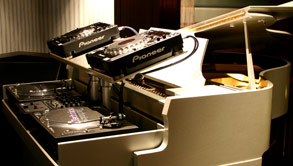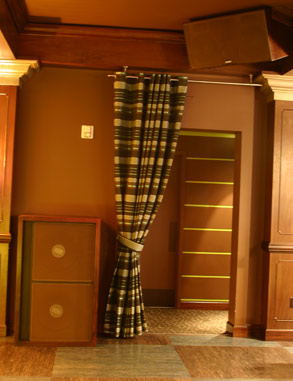Design Philosophy | Design Portfolio | Installations by JK Sound



RUBY SKYE | SLIDE | CIRCUS DISCO
Recording Studio Quality at Dance Club Levels
JK Sound Nominated for 2007 World Club Awards
JK Sound and George Karpaty have teamed up again to bring San Francisco the ultimate ultra-lounge experience. George has converted an old basement theater that was once a real 1930’s speakeasy and imbued the space with the opulence of a bygone day. Occasionally, one walks into a room and says, “They don’t build them like this anymore.” Well, George still does. Slide, named after the secrete entrance for the old gin joint, is his latest and best effort. Gorgeous materials and master craftsmanship are everywhere in sight and the experience is captivating. A real slide creates an alternate entry. The twisting brass and hardwood installation shoots guests down into the club in lieu of the stairs. The illusion of stepping into the past is perpetuated right down to the design of the DJ station: take a grand piano, raise it on a pedestal so that one could comfortably play it standing, remove the keyboard, and replace it with a custom DJ console.
Developing a sound system design for such a unique venue fell to George’s long time associate Michael Lacina, President and founder of JK Sound. Since Lacina had secured the 2006 Club World Award for best sound system for George’s club, Ruby Skye, the choice for system designer was a forgone conclusion. But the system for Slide presented a different set of challenges then those met when building a large club. The ultra-lounge experience is one in which decor and service is forefront. Sound systems tend to be good, but restrained, blending into the design. Such was the original concept for Slide. Initially, there were to be rows of the compact, low profile EAW JF80’s, arranged in delay banks, from the back of the club to the front, with all of the speakers built into the ornate molding of the mahogany beams that were to define the ceiling. But as the lounge concept developed, George made it clear that he wanted the sound system to be able to satisfy the world’s top DJ’s. After all, Slide is essentially in the basement of Ruby Skye, and if someone, say Tiesto, to use George’s example, wanted to spin a little set down at Slide, well then the system needed to be worthy. It soon became clear that George wanted a system the equal of Ruby Skye in quality and presence, if not in scale.
Lacina went to the huge palette of EAW to find speakers that might fit the bill. With over 140 models to choose from there was bound to be something that would be appropriate in size and necessary output. The bar would be located on one side of the main room, a 60 by 30 foot rectangle. So, one challenge was to put enough sound energy into the room without making it impossible for the bartenders to hear drink orders. And there was still a desire to keep the speakers from being an overbearing physical presence in a room. Although the speakers could no longer be buried into the ceiling beams, EAW Avalon series DC4’s, would fit into 6 “corner pocket” locations, with the bottom of the cabinets and beams in alignment, creating a finished look. Lacina decided to stain DC4’s to the same mahogany finish as the beams and ditched the signature Avalon chrome speaker grill for chocolate brown perforated metal.
Six DC4’s would provide sound for an area that was only 60’ x 30’, 20% of which was taken up by the bar. The only remaining problem was that there really wasn’t any place to put a sufficient quantity of subwoofers. In the original design, the subs were to be buried in the walls, but the slot for the subs got absorbed into a hallway on the final set of architectural plans. Now Lacina was faced with a need for more subwoofer output and no room to put it. The solution was not an obvious one. Lacina decided to upgrade the drivers in the EAW DC4’s and put more low frequency into the mid bass component, thereby lowering the crossover frequency for the subwoofers so that they only had to function from 65 hertz and down. He put a call into Kenton Forsythe, co-founder and President of EAW Engineering. Lacina wanted to tri-amp the DC4, which is typically a bi-amped speaker; and he wanted stout components into which he could drive twice the rated wattage. Kenton was up for the challenge, as usual, and came back with a modified DC4 that took woofers which were specially designed for EAW’s KF300 series, the midrange from the KF760 line array, and the high frequency driver from EAW’s 730 line array, thereby creating a speaker that was capable of much higher output then the original model. For grins they issued this model as the DC4/JK for Lacina’s company, JK Sound.
But of course the lounge still needed subs, and Lacina decided on a pair of SB284c’s from EAW’s Cinema series. These speakers would have a small footprint because they were designed with a shallow depth to fit behind a movie screen. They also were to be encased in mahogany before George would consider putting them on the floor and the grills of the cabinet were painted the same chocolate brown as the DC4’s at EAW’s factory. In the final modification, the woofers themselves were upgraded to Eminence Kilowatt 18’s.
To further augment the bass, customized subwoofers also were built for the three areas of Slide which feature bottle service. At either end of the main room there are two alcoves that have three booths apiece. Custom single 12” subwoofers were designed to fit under the booths to warm up those areas with rich low end. Lacina chose the same driver used in EAWs SBX220, having found it to be nearly indestructible. The overhead sound for these bottle service areas was provided be EAW CIS400 in-ceiling speakers.
The third custom sub was built and designed by Brad Katz, system integrator for JK Sound. An EAW SBX220 was supposed to sit next to a couch in a third bottle service area located directly behind the main bar, but when Katz went to install it, the couch had mysteriously grown in size and the space was no longer there. He designed around an alternative space, devising a sub that had the same internal dimensions of the SBX220, and could use the same woofers, but which would fit into a slot that was only 13 and a half inches wide. This particular bottle service area has 4 EAW JFX200 speakers surrounding its perimeter, Brad’s custom sub plus one additional standard SBX220. That is serious sound for an area that is merely 25’ x 15’.
The design parameter that Lacina developed for Ruby Skye’s sound system is carried over in almost strict doctrine onto Slide: build a system that will not flinch under pressure, that will have enough amplifier headroom as to be far above the threshold of distortion, with components that can handle the power, and finally, employ a piece of equipment which is top of its class for the signal processing portion of the task. JK Sound installed at Slide the first ever Dolby Lake processor in a night club installation. These processors have become the first choice for pro sound companies touring with top tier artists. Always one to be at the head of the pack, Lacina ordered the Dolby Lake for Slide when the only working units in the world were out on tour with no less of an artist than Madonna. The processor utilizes Lake’s patented Mesa filter that allows the engineer to create asymmetrical equalization filters that have different slopes on either side and allow for a plateau of any width on top (or below, should the filter be a cut). Recently acquired by Dolby Labs of San Francisco, Lake’s redesigned processor is now available with 4 inputs and 12 outputs, and also features new analog to digital and digital to analog converters that many engineers say are the best in the world. The processor is controlled from a wireless tablet computer, allowing the engineer the freedom to walk the room and hear the effects of different EQ settings real time. In the case of Slide, that engineer was Brad Katz, JK Sound’s master of SMAART software audio analyst, and the man who sets all JK Sound’s systems tunings. After in-depth SMAART calibration, Brad fine tuned the system during the course of opening parties, walking about with the Viewsonics Tablet PC and making adjustments that satisfied his trained ears.
The Statistics
Main speakers:
6 EAW DC4/JK’s tri-amped, customized finish and upgraded components
Subwoofers:
2 EAW SB284c dual 18” subs with upgraded woofers and customized finish
Powered by:
1 Lab Gruppen FP2600 for highs (at over 2200 watts for six 1” drivers)
1 Lab Gruppen FP3400 for mids (at over 3200 watts per six 8” drivers)
3 Crest 8001’s for lows (7200 watts mid bass for a dozen 12” drivers)
1 Crest 9001 for subs (4400 watts for four 18” drivers)
VIP areas:
6 overhead EAW CIS400 in-ceiling speakers
Subwoofers:
2 JK Sound corner sub located under the booths using EAW SBX220 woofer
2 Crest 7001 power amps: 2800 total watts
Bottle service area:
4 EAW JFX200 speakers
Subwoofers:
I EAW SBX220 dual 12” sub, 1 custom JK dual 12” sub
1 Crest 7001, 1 Crest 8001 power amps: 3600 total watts
Processing:
I Dolby Lake LP4D12 4 in 12 out digital system controller
Custom Piano console designed by George Karpaty, Michael Lacina and Brad Katz
Rane TTM57 with built in Serrato
2 pioneer CDJ1000 MK3’s
2 Technic SL1200 MK5 turntables
2 KV2 EX12 self powered DJ monitor
